Manduca schausi
|
|
Updated as per http://biological-diversity.info/sphingidae.htm (Belize), November 2007
Updated as per Fauna Entomologica De Nicarauga, November 2007
Updated as per The Known Sphingidae of Costa Rica, November 2007
Updated as per personal communication with Jose Monzon (Guatemala); May 2009
Updated as per CATE (description; Mexico, Costa Rica, Panama, Ecuador, Peru); March 7, 2011
Updated as per personal communication with Pia Oberg (Wildsumaco, Napo, Ecuador, March 1, 2011); December 1, 2011
Updated as per personal communication with Jose Ramon Alvarez Corral; (Barinas, Venezuela) May 27, 2012; ongoing
Updated as per personal communication with Brian Fletcher (Umbrellabird Lodge, Jocotoco Foundation Buenaventura Reserve, nr. Pinas, El Oro, Ecuador,
February 28, 2014, 1200m); March 12, 2014
Updated as per personal communication with Ezequiel Bustos (Shilap revta. lepid. 43 (172) diciembre, 2015, 615-631 eISSN 2340-4078 ISSN 0300-5267), January 4, 2016
|
Manduca schausi
(Clark, 1919) Protoparce
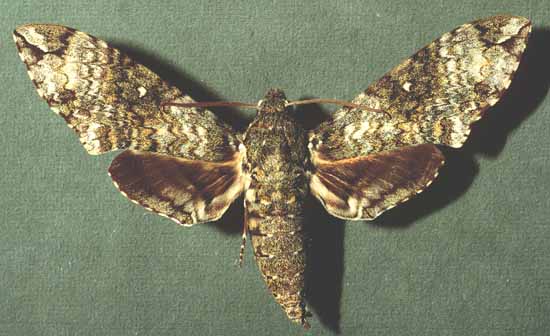
Manduca schausi male courtesy of Dan Janzen.
This site has been created by
Bill Oehlke at oehlkew@islandtelecom.com
Comments, suggestions and/or additional information are welcomed by Bill.
TAXONOMY:
Family: Sphingidae, Latreille, 1802
Subfamily: Sphinginae, Latreille, [1802]
Tribe: Sphingini, Latreille, 1802
Genus: Manduca Hubner, [1807] ...........
Species: schausi (Clark, 1919)
|
MIDI MUSIC
.....It's a Wonderful World.....
copyright C. Odenkirk
ON.OFF
<bgsound src="world.mid" LOOP=FOREVER>
|
DISTRIBUTION:
Manduca schausi (forewing length: males: 48mm; females: 64mm)
(wingspan: 114 mm - 138 mm, females larger than males)
flies in
Rio de Janeiro, Brazil (specimen type locality), and
generally from
Mexico;
Guatemala: Izabal (JM);
Nicaragua: Esteli, Jinotega,
Granada, Rio San Juan;
Costa Rica: Guanacaste, Puntarenas, Alajuela,
carthage, San Jose, Heredia;
Panama: Chiriqui;
to
Colombia;
Venezuela: Barinas (JRAC);
Ecuador: Napo: Wildsumaco Lodge;
Peru;
Bolivia:
La Paz: Murillo, Río Zongo, 750m; Nor Yungas, Coroico, 1200m;
Santa Cruz: Sarah, 450m; and
now confirmed in Argentina: Tucuma (EB).
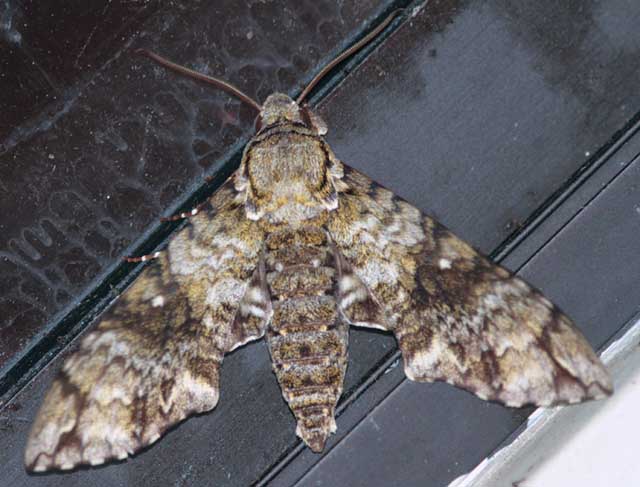
Manduca schausi, Wildsumaco Lodge, Napo, Ecuador,
March 1, 2011, courtesy of Pia Oberg.

Manduca schausi, Umbrellabird Lodge, Jocotoco Foundation Buenaventura Reserve,
near Pinas, El Oro, Ecuador,
February 28, 2014, 1200m, id by Jean Haxaire
Intermediate between Manduca lichenea and Manduca florestan, with similar pattern to both. General coloration on body and forewing
grey with a green tinge, like Manduca florestan, but forewing upperside darker, especially the semicircular median area on the costal margin. Forewing
narrower than Manduca florestan, more similar to Manduca lichenea, with similar concavity on the distal margin just anterior to the hind angle.
Forewing upperside stigma much smaller than either Manduca lichenea or Manduca florestan. CATE
Note two short black dashes below white cell marking; white streak atop lower border of black apical marking.
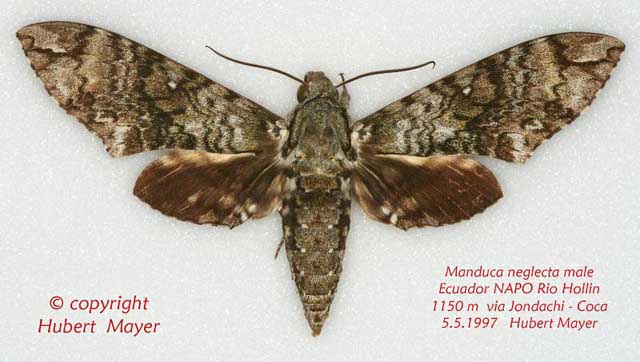
Manduca schausi male, Napo, Ecuador,
May 5, 1997, 1150m, courtesy of
Hubert Mayer,
identification corrected to M. schausi
by Jean Haxaire.
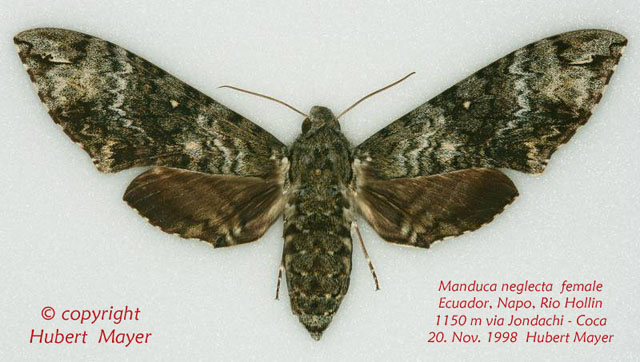
Manduca schausi female, Napo, Ecuador,
November 20, 1998, 1150m, courtesy of
Hubert Mayer,
identification corrected to M. schausi
by Jean Haxaire.
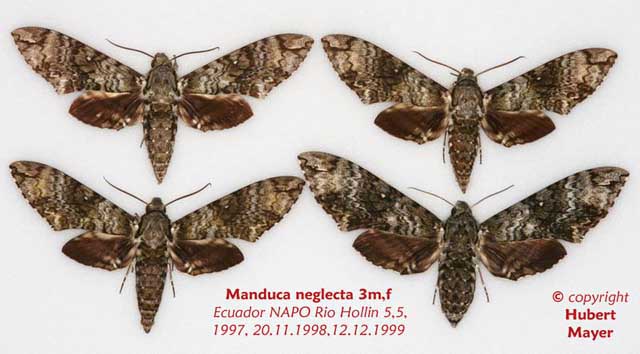
Manduca schausi, three males and a female, Napo Ecuador,
November-December, courtesy of
Hubert Mayer,
identification corrected to M. schausi by Jean Haxaire.
FLIGHT TIMES:
Manduca schausi adults fly in all
months except March in Costa Rica, but main
flight seems to be in May and June. Pia Oberg, however, reports a March flight in Ecuador.
Both males and females come to
lights.
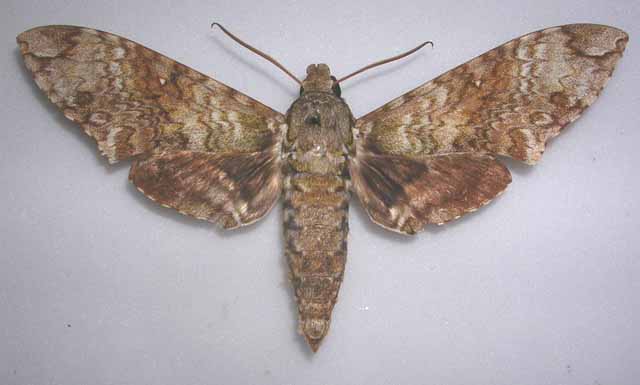
Manduca schausi, Costa-Rica, Tuis-Cartago,
courtesy of Frederik Goussey.
ECLOSION:
Pupae probably wiggle to surface from subterranean chambers just prior to eclosion.
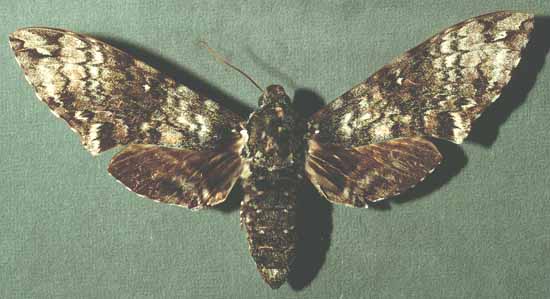
Manduca schausi female courtesy of Dan Janzen.
SCENTING AND MATING:
Females call in the males with a pheromone released from a gland at the tip of
the abdomen.
EGGS, LARVAE, PUPAE:
Larvae feed on Capsicum annuum and
Lycopersicon esculentum.
Use your browser "Back" button to return to the previous page.
Return to Sphingidae Index
Return to Sphingini Tribe
Use your browser "Back" button to return to the previous page.
This page is brought to you by
Bill Oehlke and the
WLSS. Pages are on space rented from Bizland. If you would like
to become a "Patron of the Sphingidae Site", contact Bill.
Please send sightings/images to Bill. I will do my best to respond to
requests for identification help.
Enjoy one of nature's wonderments: Live
Saturniidae (Giant Silkmoth) cocoons.
 | 
Show appreciation for this site by clicking on flashing butterfly to the left.
The link will take you to a page with links to many insect sites. |









